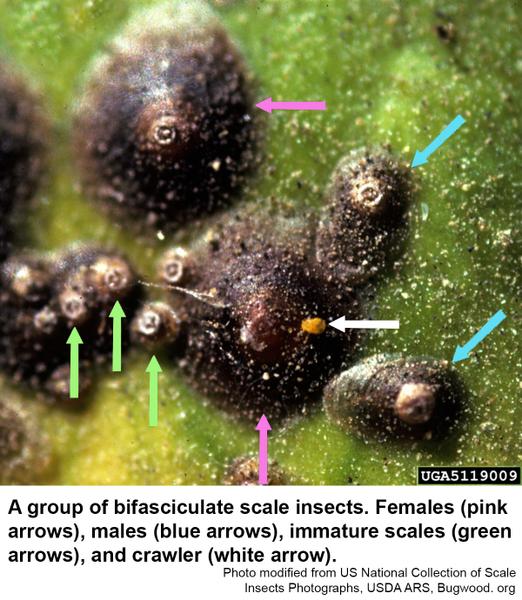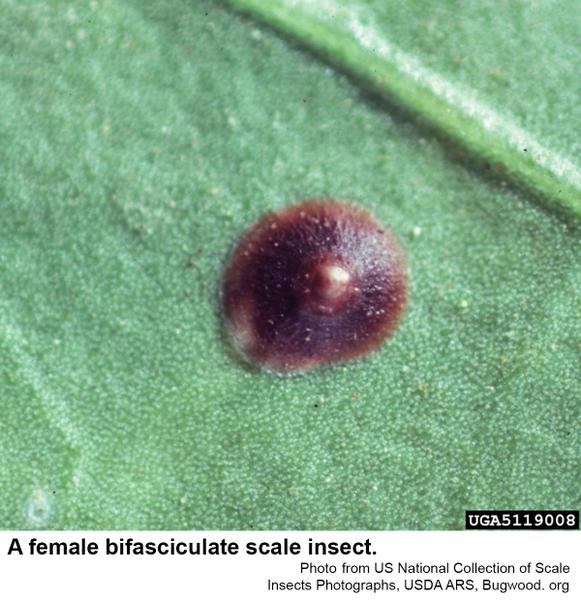Description and Biology
Bifasciculate scale insects, Chrysomphalus bifasciculatus, are typical armored scale insects. It is also known as the false Florida red scale. Females secrete more or less circular test (armor) and males secrete smaller, oval armors. The armor is shallowly convex, and in its center the first instar cast skin is typically lighter than the rest of the brown to almost black armor. The actual female is yellow to dark yellow. Eggs are laid in mid spring and crawlers and emerge from under the mother scale's armor. Female crawlers settle down to feed and do not move again. They molt a few times before maturing into adults. Male crawlers settle down to feed and develop, but the adult male is a tiny, two-winged insect that seeks out females to mate through a flap at the edge of the female armor. Males die soon after mating. At least two generations occur each growing season. The summer generation develops somewhat faster than the spring generation.
Host Plants
Bifasciculate scale insects are most commonly found on English ivy and hollies in North Carolina. Other hosts include aucuba, boxwood, camellia, elaeagnus, euonymus, honeysuckle, ligustrum, osmanthus, and pittosporum. Across the world, this scale has been reported from 40 hosts plant genera in 26 plant families. Bifisciculate scales also infest palms, rubber plants, and figs in greenhouses.
Residential Recommendations
The armor of bifasciculate scales protects the from many (but not all) parasites and predators. The armor also protects them from some pesticides. Fortunately, armored scales are susceptible to horticultural oils because oils have low surface tension and can creep through the opening through which males mate with female scales. Several brands of oils are on the market. These oils are relatively safe for humans and pets, and they are moderately toxic to armored scales, soft scales, aphids, and mites. Oils leave little toxic residue behind to threaten beneficial insects and mites that prey upon various kinds of scale insects. Wait until the new growth has emerged and hardened off a little. The first week in June would be a very good time to spray. Use 5 tablespoons of oil in a gallon of water, shake it up, and spray thoroughly. It is probably a good idea to spray the infested shrubs again two weeks later. If the weather is dry and hot, spray either in the cool of the morning or cool of the evening. Water drought-stressed plants before spraying.
References
- Armored Scale Identification and Management on Ornamental Plants. Frank, S. 2010. Entomology Insect Notes, NC State Extension Publications.
- Armored Scale Insect Pests of Trees and Shrubs (Hemiptera : Diaspididae). Miller, D. R. and J. A. Davidson. 2005. Cornell University Press 442 pp.
- First Florida State Record of Chrysomphalus bifasciculatus Ferris (Diaspididae: Coccidomorpha: Hemiptera), False Florida Red Scale, Potential Pest of Ornamentals and Citrus. Ahmed, M. Z. and D. Miller. 2018. Circular, Florida Department of Agriculture and Consumer Services, Division of Plant Industry. FDACS-P-1907
- Extension Plant Pathology Publications and Factsheets
- Horticultural Science Publications
- North Carolina Agricultural Chemicals Manual
For assistance with a specific problem, contact your local N.C. Cooperative Extension Center
This Factsheet has not been peer reviewed.
Publication date: April 29, 2016
Reviewed/Revised: Oct. 9, 2019
Recommendations for the use of agricultural chemicals are included in this publication as a convenience to the reader. The use of brand names and any mention or listing of commercial products or services in this publication does not imply endorsement by NC State University or N.C. A&T State University nor discrimination against similar products or services not mentioned. Individuals who use agricultural chemicals are responsible for ensuring that the intended use complies with current regulations and conforms to the product label. Be sure to obtain current information about usage regulations and examine a current product label before applying any chemical. For assistance, contact your local N.C. Cooperative Extension county center.
N.C. Cooperative Extension prohibits discrimination and harassment regardless of age, color, disability, family and marital status, gender identity, national origin, political beliefs, race, religion, sex (including pregnancy), sexual orientation and veteran status.



